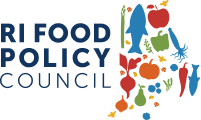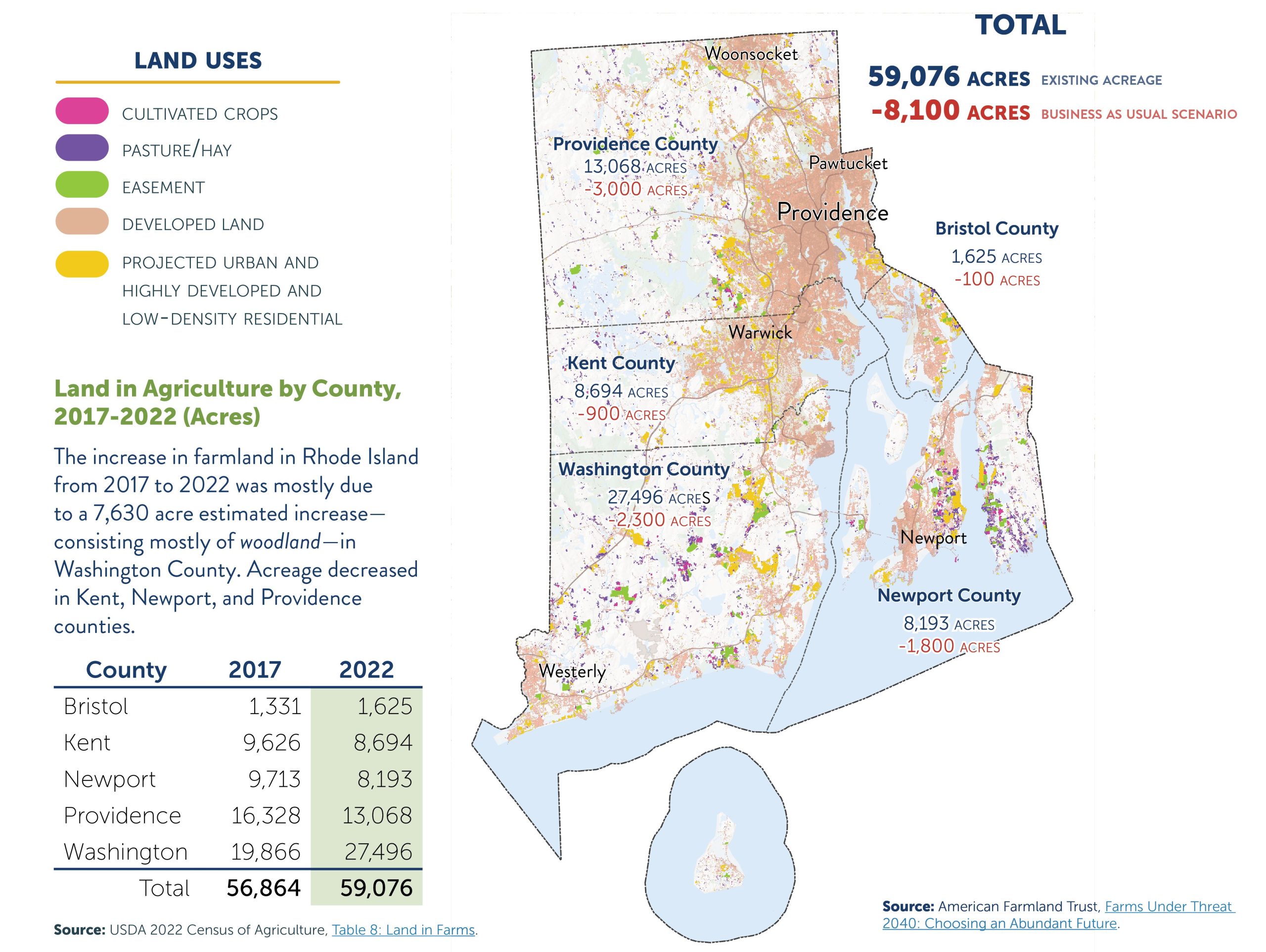How to get the most out of this dashboard
- Read through from top to bottom to get the whole story
- Scroll over the charts to get nitty gritty details
- Click on a color in the Key to hone in on that selection
- Enter Full Screen Mode by clicking this button
 in the lower right of each chart
in the lower right of each chart
Land in Agriculture in Rhode Island by County, 2002-2022
The USDA Census of Agriculture is conducted every 5 years and provides foundational information on characteristics of agriculture in every county and state in the country. Back in 1920, Rhode Island had an estimated 331,600 acres in farmland. As of the 2022 Census of Agriculture, Rhode Island was estimated to have 59,076 acres in farmland, which is an increase from 56,864 in 2017. In 2022, Washington County accounted for 46.5% (27,496 acres, an increase from 19,866 acres in 2017) of land in agriculture, while Providence County made up about 22.1% (13,068 acres). Newport, Kent, and Bristol counties contain much smaller amounts of land in agriculture.
Land in Agriculture in Rhode Island by Category, 2002-2022
This chart has an interactive menu!
Click the Year menu on the left and use the arrows for more information.

Woodland is the largest category of agricultural land in Rhode Island: 27,595 acres (46.7%) of total in 2022. Woodland includes natural or planted woodlots or timber tracts, cutover and deforested land with young growth which has or will have value for wood products, and woodland pastured. It also includes land with tapped maple trees. Total cropland in Rhode Island equaled 16,665 acres (28.2%) in 2022, and is mostly hay and other forage, followed by vegetables, corn for animal feed, and fruit orchards.
Note: data is suppressed for some counties and categories for multiple years.
Projected Agricultural Land Conversion
According to the 2022 USDA Census of Agriculture, Rhode Island had 59,076 acres of agriculture. A decrease of 8,100 acres would mean a 13.7% decrease in available farmland.
Figure: Hunter, M., A. Sorensen, T. Nogeire-McRae, S. Beck, S. Shutts, R. Murphy. 2022. Farms Under Threat 2040: Choosing an Abundant Future. Washington, D.C.: American Farmland Trust.
Farm Real Estate Average Value Per Acre, 2006-2024
The average price per acre of farmland in Rhode Island has been over $20,000 for the past 19 years. This is the highest average price per acre in the country. Farm real estate value is a measurement of the value of all land and buildings on farms. The national average for 2024 was $4,170 per acre.
Rhode Island has the most expensive farm real estate values due to its small land area and development pressure.
Number of Farms in Rhode Island by County, 2002-2022
In 2022, Providence County accounted for 34.3% of farms (362), with an average farm size of 36 acres (the average size of a farm in the United States in 2022 was 463 acres). Washington County accounted for 30.7% of farms (324), with an average farm of 85 acres.
Number of Farms in Rhode Island by County and Category, 2002-2022
Click the Year menu on the left and use the arrows for more information.

The number of farms in Rhode Island was estimated at 1,043 in 2017 and 1,054 in 2022. Note that most farms are engaged in more than one type of agricultural activity. The bars in this figure are not mutually exclusive. Nearly 29% (302) of all farms in Rhode Island grow vegetables/melons, 22% (231) grow greenhouse/nursery products, and 20% (210) raise poultry/eggs.
Value of Agricultural Sales by County and Category, 2002-2022
This chart has an interactive menu!
Click the Year menu on the left and use the arrows for more information.

Agricultural sales in Rhode Island increased from $80.4 million in 2017, to $86.2 million in 2022. With its limited landmass, Rhode Island is heavily invested in inedible products.
Greenhouses/nurseries/floriculture accounted for 21.9% of farms and 63.8% of sales in 2022, and most of the sales increase from 2017 to 2022 was due to greenhouse/nursery/floriculture sales.
Washington County has the largest amount of farmland and accounted for 47.7% agricultural sales of Rhode Island counties in 2022.
Data sources: USDA Census of Agriculture, Table 2: Market Value of Agricultural Products Sold, multiple years. Adjusted for inflation to 2024 dollars. Note: USDA estimates of aquaculture sales are not included here. Aquaculture sales estimates from the RI Coastal Resources Management Council are shown under Seafood and Commercial Fisheries.
Value of Edible Agricultural Sales by County and Category, 2002-2022
This chart has an interactive menu!
Click the Year menu on the left and use the arrows for more information.

According to the USDA Census of Agriculture, which is generally believed to undercount this measure, edible agricultural products made up 34.6% ($29.8 million) of the total value of agricultural sales in 2022. Vegetables and melons made up the majority of edible agricultural product sales, followed by fruits and berries, and cattle. Newport County actually accounted for the highest percentage of total edible product sales (14.6%), followed by Washington (13.8%), and Providence (11.8%) counties.
Number of Farms and Value of Agricultural Sales by Economic Class, 2002-2022
This chart has an interactive menu!
Click the Year menu on the left and use the arrows for more information.

A little more than 81% (857 farms) of Rhode Island farms had sales of less than $50,000 in 2022, and these farms accounted for 8.4% ($7,795,000) of total sales. On the other end of the spectrum, 41 farms (3.9% of farms) had sales of $500,000 or more, and these farms accounted for 65.6% ($60,874,000) of total sales.
This scale asymmetry is endemic in every state and highlights the challenges of farm viability for small and midsize producers.
Estimating the Value of Rhode Island’s Food System
The USDA Census of Agriculture, conducted every 5 years, is the foundational data source for food system analyses. It allows for longitudinal, county-to-county, and state-to-state comparisons.
However, local research has found that the Census of Agriculture underestimates the value of food production. For example, the USDA estimate for sales in 2007 was $65.9 million ($81.3 million in 2020 dollars). Using a different approach, University of Rhode Island Professor Tom Sproul conservatively estimated that Rhode Island had agricultural sales of nearly $170.6 million in 2007, more than 2.5 times higher than the USDA estimate. A 2012 update estimated $238.9 million in sales, compared to $59.6 from the 2012 Census of Agriculture. Dr. Sproul’s estimates do match USDA estimates in the sense that greenhouse/nursery sales account for the majority of sales in his analysis.
URI Agricultural Sales Estimate, 2012
Greenhouse, nursery, and floriculture sales made up the biggest percentage, 41.3% ($122.7 million), followed by crop production, 23.7% ($70.3 million), animal production, 16.5% ($49.1 million), and smaller amounts of grape vineyards and aquaculture.
RI Food Data Discrepancies:
Available Information, Their Methodologies, and Differences
Farmer Age Demographics, 2007-2022
At the same time, Rhode Island actually has the highest percentage of new and beginning farmers—farmers with 10 or fewer years of experience—of any state in the country: 41.4% (802 out of 1,938) in 2022.
Young Farmers, 2017-2022
Farmer Race Demographics, 2007-2022
Colonization, genocide, slavery, and policies pursued by the U.S. government all played a role in the dismantling of Indigenous societies and limited access to agricultural land for non-White people. Today, Black, Indigenous, Asian, and Hispanic Americans own a very small percentage of farms and agricultural land.
Farm ownership in both the state and the country continues to be a mostly White-owned enterprise: White people make up 60% of our country’s population, but comprise 92% of producers, own 96% of farms, and operate 94% of land in agriculture. As of July 2022, 69.9% of Rhode Islanders were White (not Hispanic), but 97.2% of Rhode Island farmers were White. Black Americans make up 9.1% of Rhode Island’s population, but only 1.0% of farmers.
Farmer Demographics by Hispanic Ethnicity, 2007-2022
Hispanic Rhode Islanders–the state’s largest ethnic group–make up 17.6% of the state’s population, but make only 1.7% of farmers.
Farmer Sex Demographics, 2007-2022
Women make up 51% of Rhode Island’s population but 42.9% (832) of farmers. This percentage does represent an increase from 35% (659) of farmers in 2007.


